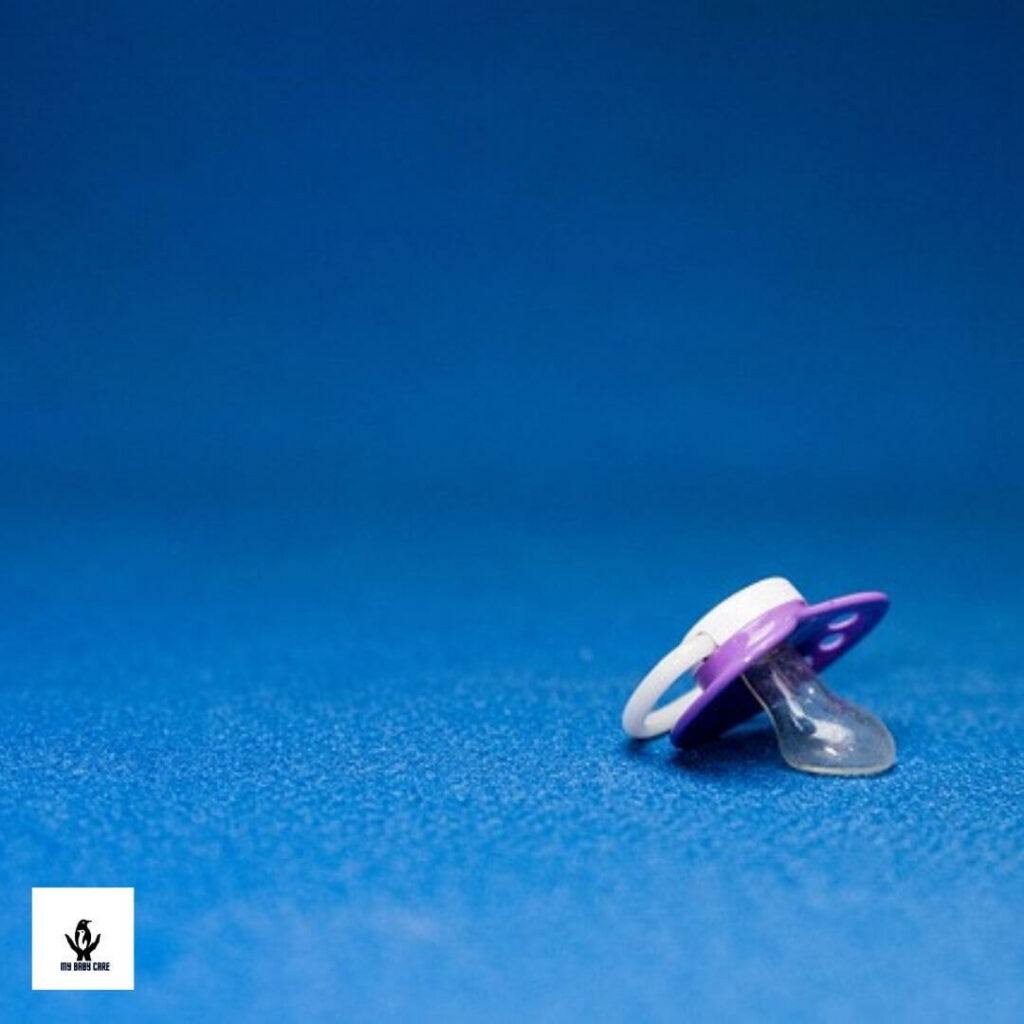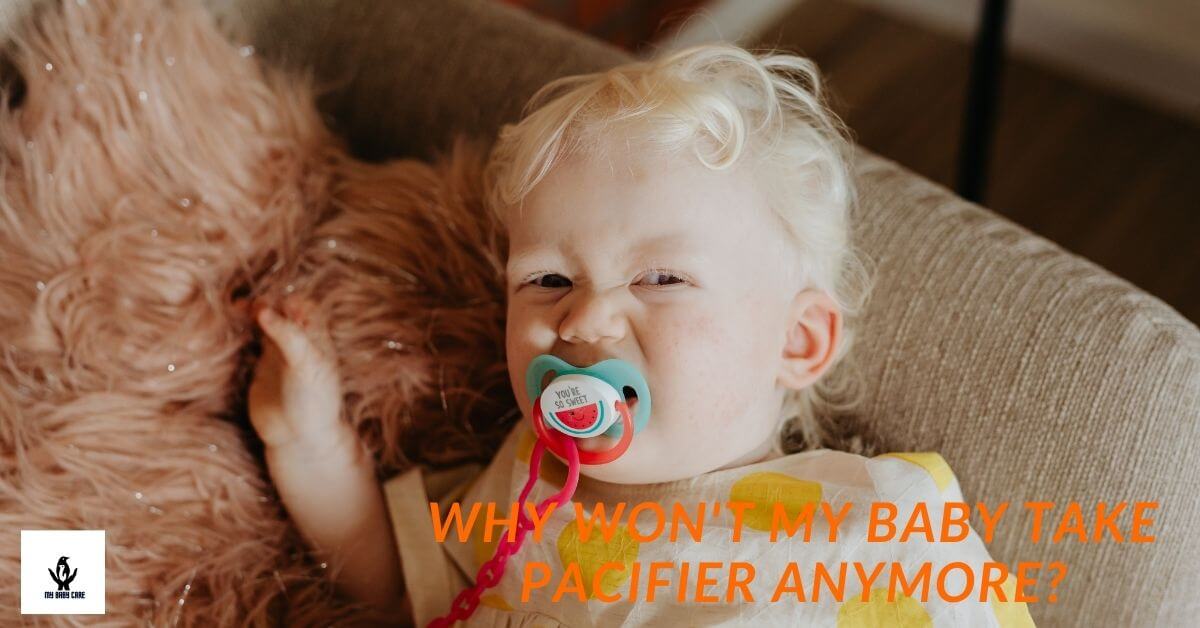Why won’t my baby take pacifier anymore? It is the most common complaint of new parents. Most of the kids suddenly refuse the pacifier. Sometimes they chuck it across the room. Sometimes chew it on the wrong side or both sides. They try to throw it away at the sleeping time and are mostly brutal at the sleeping time.
Some kids only chew it for minutes and throw it away. Few kids are getting calm with the pacifier and the tether together.
Table of Contents
1. Common pacifier problems
- Most of the kids latch on to the pacifier incorrectly. You may have experienced that breastfed babies always open mouth widely to take on the breast. These kids take the whole dummy into the mouth by opening the mouth automatically when the parents give it to them.
- Other categories of kids take the dummy a few weeks nicely and then stop it suddenly.
2. Simple steps for your baby to take a pacifier
Dear parents, I recommend that you need to keep few different dummies with you. Then you can practice those dummy pacifiers with your baby one by one. So think about it. Various shapes. It should be made attractive shapes and designs between the rubber and the silicon materials. Also, you need to match the correct size of your pacifier with the baby’s age.
You need to divide the separate times of the day and give those various pacifiers to soothe your baby. Sometimes try it as soon as you finish feeding.
You need to use the dummy pacifier to stimulate the baby’s reflex action of sucking rather than conscious action. So try it when the baby is sleepy. Then baby sucks it spontaneously.
Make sure to introduce the pacifier at the correct time. I mean the proper age. This can be judgmentally decided with the breastfeeding of your baby. If your baby can maintain proper latch while sucking the breast for a few minutes, then you can think of giving a pacifier to your baby.
You should not force your child at all when you introduce a pacifier.
It will backfire and the child will hate the pacifier for a long time. You should understand that if the child shows resistance, then you can try to separate multiple times. If the child sucks his thumb, leave it like that and it may be a sign that you can introduce the pacifier later.
Always choose a time in the end of a Feeding session to introduce the pacifier. You can introduce the dummy when the baby slows the nipple sucking. Here the child is so sleepy with a full tummy and he/she may not identify the difference.
You can try this new pacifier by smearing a little breast milk on it. It will kindle the child’s interest and do active sucking rather than bluntly refusing it.
Always keep two-three days gap after each failed attempt. Restart trying when the child is tired and sleepy. Never try to use it when your infant is cranky. If all these fail, you can choose new pacifiers with various colors and other forms of materials.
Make sure to keep adequate time gaps to introduce these above-mentioned tactics.
3. What are the motivation techniques for your baby to take a pacifier
You need to start holding your baby in the correct position. So practice the ” colic carry position” with your baby all the time. Then you can soothe the crying or upset baby effectively. After swaddles gently your baby after a warm bath. You can use some moisturizing lotion to head to toe massage of your baby to get maximum results in this procedure.
Use a comfortable baby carrier if your baby continuously cries and reduce to take the pacifier. Always try to keep the baby near to your heart and the chest allowing him/her to listen to your heartbeat. You can switch your music player into calming music or another kind of relaxing music type to maximize the effectiveness of the procedure. Finally, try to record all these simple steps and how the baby responded to them in short and evaluate all those things later. This simple technique will help you to design the most effective daily routine for your kid.
Dear parents, recommend that you need to have a proper understanding of the daily needs of your baby. So the best way to get an idea for that is to keep a record and monitor them day by day. After identifying most of those needed things you can easily soothe your baby nicely with a pacifier.

4. Simple checklist of daily necessities amplify the pacifier taking.
- Your baby needs to feed more. He/she might be hungry.
- The baby might have a dirty diaper
- Some babies have gas. So try to carry baby anti-colic carry position immediately.
- Think about the time period of the year. The baby may be cold in the winter seasons or they might be hot in the summer seasons.
- Sometimes your baby might be sick or tired. Think closely about those aspects as well.
- Within a day your baby might be overstimulated or bored most of the time.
I suggest here that you need to avoid most of this simple troublesome situation for your baby each day.
5. How do you respond when the child withdraws the pacifier
You need to think of a tricky intervention as soon as you see this type of withdrawal. So try to introduce self-soothing techniques like thumb sucking gradually. You can think creatively about the other soothing techniques which are more relevant to your baby.
Also, wait until the baby falls asleep. These sleeping times are more effective with most of the kids to introduce the dummy pacifiers most of the time. If it does not work, don’t try to force your kid any longer. Tell the kid softly that you don’t want your baby to do that as the baby can understand most of your body language. Sometimes there may be other effective methods to soothe your baby rather than giving a pacifier.
6. How to keep a pacifier in your newborn mouth
your little one drops their pacifier for no reason most of the time. The baby might convert the replacing the dummy as a funny activity. So you should be careful to handle this thing.
Dear parents, you need to establish a stronghold while the baby sucking the pacifier. You can pull the dummy simply when the child is sucking it. Then he/she might tighten the oral muscles to hold it and this sequential activity can be considered as a strengthening activity for the baby. After some time the pacifier is less likely to fall off from the mouth.
Also, you need to choose the exact size of the pacifier for the baby that will be beneficial for you all to practice the above activities with the kid.
Don’t take these so hard. These simple techniques I told here may be very difficult at the beginning, once the infant gets used to the dummy, it may be hard to remove it from their mouth.
7. Especial holding pattern to train pacifier with your baby
This posture should be encouraged your baby to take the pacifier. Hold your baby just like you are trying to feed them. The baby’s arms into their sides and the hands in the center of the chest. You should tuck up the little knees of the baby allowing their feet to rest on the crook of the parent’s elbow. This is a kind of fixed position and it will encourage the baby’s sucking.
You can take the pacifier pushing your index finger into its center just behind the mouth guard and dip it with breast milk or formula and finally touch the baby’s lower lip. This method will elicit the rooting reflex and the baby will open its mouth. You can gently insert the pacifier and apply gentle pressure
practice these methods for few days multiple times during the day.
8. Can your baby sleep with a pacifier in his/her mouth
The simple answer is you can use the pacifier with your baby even with sleeping. But most parents worry about possible damages to their baby’s teeth. Some parents don’t like to use it all night. but we strongly recommend this as sucking a pacifier can significantly reduce the risk of SIDS ( sudden infant death syndrome ).
We explain this as more similar to sucking a baby’s thumbs all night. So I suggest that you can give a comforting mechanism for your child until they are at the age of three. There is enough research to say that it is not going to be trouble for your baby.
Sleeping through a whole night is a huge milestone in your baby’s development. The baby should reach this at the age of 6 months. The feeding patterns throughout the day, switching between breastfeeding and bottle feeding also have a role to play in doing this. Additionally, the pacifier is a good option to achieve these milestones with your baby.
It is very important for you to replace the dummy frequently if you allow your tiny tot to use it for extended hours. Find special dummies especially design for nighttime usage in case you plan to give the pacifier for extended hours.
9.Final thoughts
Dear Parents, Don’t be negative. never think that ” my baby won’t get a pacifier “. Instead, you can follow the above-mentioned tiny tips. Make sure to keep adequate time gaps in between each step to implement. Always try to keep journals of your baby and not every single step of the first year of your baby. That is a very important thing. You can additionally use a first-year memory book for doing that.
Don’t try to give the pacifiers for the wrong cues. Also, avoid giving frequently to prevent the baby’s crying. You need to verify the actual reason for the baby’s crying. Sometimes it may be another reason such as the baby is hungry or having a wet diaper. If not they need their parental interaction more, Sometimes too cold or too hot. So as parents you need to identify the actual reason which the baby causing upset.
We strongly recommend the pacifier can only be used with a tired or colicky baby. Make sure not to give the pacifier in irrelevant situations. Then your baby will learn that the pacifier is a useless thing, some might develop an aversion and they never take the pacifier again.

